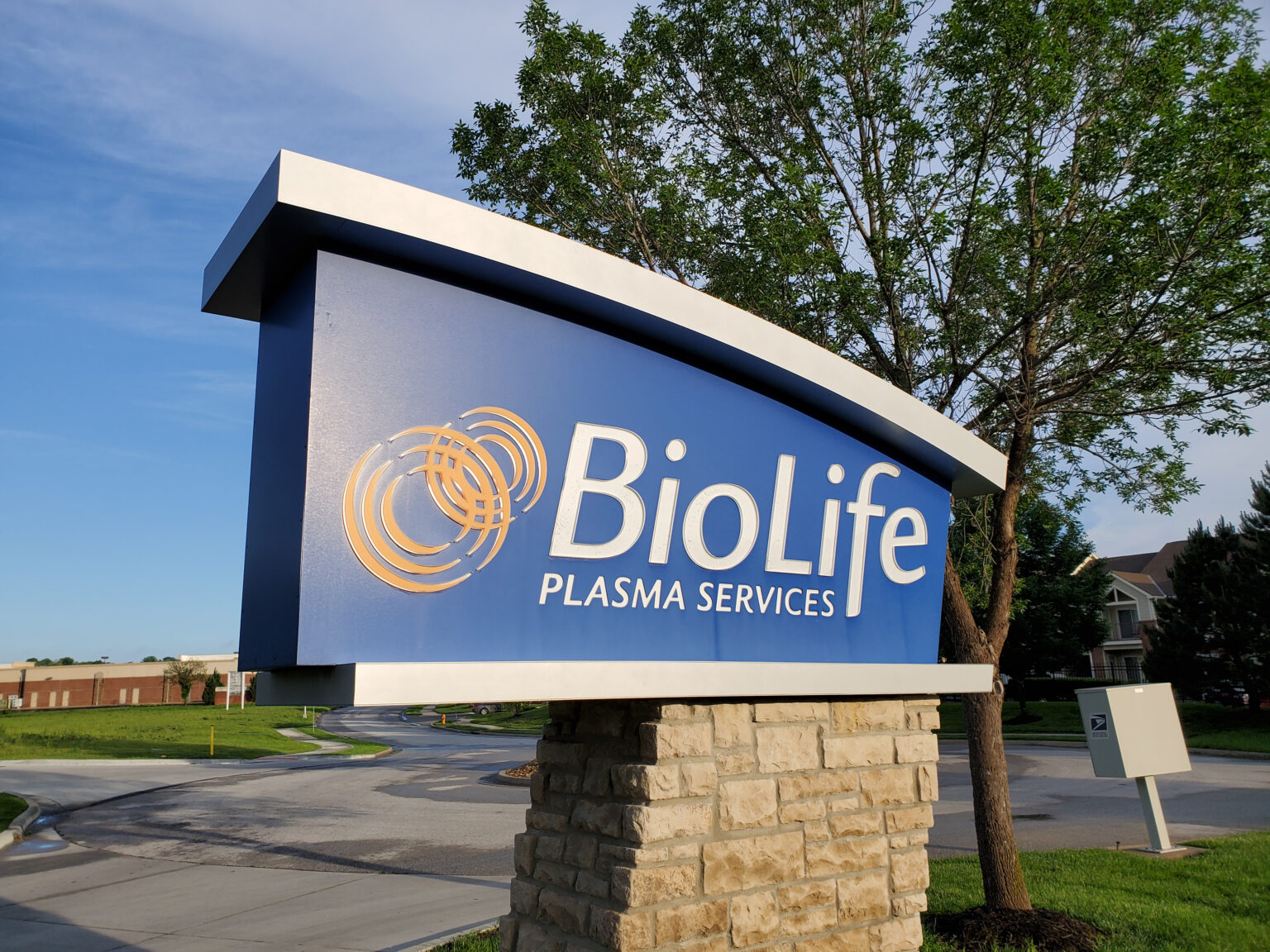BioLife’s donor compensation varies by location but generally ranges between $40 and $90 per visit for returning donors and $90 to $130 for new donors.[1]
You can donate up to twice per week, and BioLife pays you after each donation via a reloadable BioLife Debit Card.[2][1]
Below, I detail the plasma donation requirements, process, and payment policy at BioLife Plasma Services.
How Much Does BioLife Pay for Plasma?
The exact amount BioLife Plasma Services pays for plasma donation varies by location, current promotions, and how often you donate.[3]
First-time donors receive bonus pay for their first eight donations when made within one month, ranging from around $90 to $130 per donation.[3]
You can see current rates and bonuses for new donors using the BioLife Donation Center locator. Select your nearest location, then tap on the coupon for new donors to see the details.[3]
After your first month, compensation is typically about $40 for your first visit and $80 to $90 for your second visit within the week.[3] BioLife recognizes a week as beginning on Monday.[4]
Your weight may affect payment, as well, depending on the location. You’ll find these details once you’ve created an account in the BioLife app.[3]
By making two donations a week, returning donors can potentially earn up to about $520 per month.[3]
For specific compensation, it’s best to contact your local BioLife donation center.
Rewards and Bonuses
You can earn points through the My BioLife Rewards program by making plasma donations, referring a friend, having a birthday, and more.[5][6]
Donors can redeem points for rewards like money, gift cards, and charitable donations.[5][6]
You can also get a Buddy Bonus by referring a friend. Bonus amounts vary by location but are usually around $50 to $100.[7][3]
You can find your nearest BioLife’s Buddy Bonus by visiting its Donation Center page. From there, tap on the Buddy Bonus coupon to print, sign, and give to a friend to take with them for their first donation.[7]
Payment Method
BioLife pays donors with the BioLife Debit Card, a prepaid card you can use at any store that takes Mastercard.[8]
It isn’t a credit card, so you can’t charge more than the balance available on the card, but you can use it at an ATM to withdraw cash.[8]
You can also transfer funds to your bank account, though there is a fee of about $2 for transfers of less than $300.[8]
BioLife loads payment onto your card immediately at the end of the appointment.[8]
Fees
There’s a $0.50 fee to check your card’s balance at an ATM.[9]
There’s also a fee of $2.25 to make more than one withdrawal at an ATM between plasma donations. Biolife doesn’t charge anything for the first withdrawal;[9] however, the ATM might.
Over-the-counter cash withdrawals from the bank have a fee of around $3 and if you lose your card, the replacement fee is about $5.[9]
BioLife Plasma Services Donation Process
Eligibility
Donors at BioLife must be at least 18 years old and weigh at least 110 pounds.[10] (See the list of places where you can weigh yourself for free.)
You should also be in generally good health at the time of each donation.[10]
Requirements and Steps
The donation process includes identity and health screenings before the donation itself.[10]
All donors will need to provide the following at check-in:[10]
- A valid, unexpired government-issued photo ID
- Proof of address
- Proof of social security number
You’ll also undergo a medical history interview and health screening.[10]
Donors who have consumed alcohol on the day of a planned donation, are taking antibiotics for certain reasons, have recently had certain vaccinations, or have certain medical conditions like infectious diseases may not be eligible to donate.[11]
If you pass the medical history check and health screening, a phlebotomist will set you up to donate; the donation process takes about one to two hours.[12]
Find more details on how to donate plasma for money.
Safety
Donating plasma is generally a low-risk procedure. You might feel weak after donating or feel some pain at the donation site; be sure to eat a small meal, drink water, and rest well before and after your appointment.[13]
Tip: It’s best to avoid smoking, alcohol, and fatty foods before and/or after donating. Eating healthy, iron-rich food and drinking plenty of water will help keep you feeling good.[13][14]
Alternatives
For additional options, see where else to donate plasma for money.
It’s a good idea to check out a few different places in your area to be sure you’re getting the best compensation for your time and feel comfortable at the donation center.
FAQ
Generally, funds are available immediately after donating — sometimes before you even leave the donation chair. Occasionally, a glitch in the system may cause it to take up to two hours, however.[3][8]
You can check your BioLife Debit Card balance by texting “BAL” to 445544, calling the number on the back of the card, visiting an ATM, or accessing your account online or in the app.[8] If you don’t have an online account yet, you can register your card and create one through North Lane’s account management portal.[8]
If you lose your card or someone steals it, you should visit your nearest BioLife Center or call North Lane at (888) 472-0099. Your card has “Zero Liability” protection, so the card provider will refund any unauthorized purchases to the replacement card, though there is a replacement card fee of around $5.[9][15]
In Summary
Pay rates vary by location, but BioLife Plasma Services generally offers new donors between $90 and $130 per donation for the first month.[3]
Returning donors are usually paid around $40 for their first donation of the week and $80 to $90 for their second donation.[3]
You can donate plasma up to twice per week. BioLife loads donor compensation, bonus earnings, and rewards onto a BioLife Debit Card.[3]
Before making your first donation, you must complete a health and identity screening, as well as meet BioLife’s physical requirements.[10]
In the comments section below, you can ask questions, offer advice, and share your own experiences with BioLife Plasma Services. Hearing from others can be especially helpful to someone who’s new to donating plasma.
 William Lipovsky
William Lipovsky







I have Rh-negative blood. Can I still donate?
Hello, Lisa! Yes, you can usually donate with Rh-negative blood as long as you meet the other medical screening requirements. Some plasma donation centers (including Biotest, KEDPLASMA, and Grifols) have specific programs for those with Rh-negative blood, which use their donations to help prevent pregnancy complications for Rh-negative women. Best of luck with your donation!
New to this and not computer savvy. Could I just walk in to get questions answered?
Hello, Jim! BioLife Donation Centers typically require an appointment. You may be able to walk in and speak with someone, but it would be best to contact your local plasma donation center by phone. You can visit the BioLife Plasma Services website and click on your state to find your local donation center’s phone number. Best of luck!
I’m a 62 year old male in very good condition. Had a heart attack back in 2008, but other than that and typical heart medications, I’m quite fit and healthy. Does age and medication prevent this type of donation?
If not, what could be the side effects, if any, after the donation? Would the donation prevent me from driving a car soon after?
Hi Harvy,
Your past heart attack and current heart medications will not likely disqualify you from donating plasma at BioLife. According to their site, “In most cases, taking medications does not disqualify you from donating plasma. Your acceptance into the plasmapheresis program mostly depends on the type and severity of the medical condition(s) for which you are being treated.”
Is there a higher compensation rate if you are Rh negative? I thought I read that somewhere, so could that be the difference in compensation rates?
Hi Mary,
We reached out to Biolife and while we haven’t heard back from them yet, we found that some donation companies do pay those who are Rh negative higher rates. We will let you know when Biolife provides us with an answer.
Hi Mary,
Just wanted to provide you with a solid answer to your question. We received word back from BioLife and found that “BioLife does not pay extra for different types of plasma. All source plasma is paid out the same.”
Hi today was my 4th donation at biolife in Hayden an I know the first time was 20 witch I can understand my second time I only received 19 witch was confusing an my last two times I recived 20 again I’m just curious to why all my friends that go there, same donation center recive 50 every time some of my friends have been receiving since day one. Am I doing something wrong?
Hi Malynia,
There’s often some confusion about how much donors are compensated. We contacted BioLife, who told us that the first donation in a week is usually $20, and the second donation in a week can be anywhere from $30-$50 (exact amounts vary based on location). They consider one week to be Monday through Thursday. We updated the article to clear up the compensation difference between a first and second weekly visit.
In Hayden, Idaho, the second donation in one week is $50, which tells me that perhaps the other donors you talked to were referring to their second weekly donation. It sounds like if your schedule permits, donating twice in one week can be very lucrative!
I currently have just signed up to donate at the Oshkosh WI donation center. If I live in that town for college, but don’t have my name on any of the bills that get mailed there, how could I prove my address? Is this one of the places that’s an exception since its a college town? I’m a new donor and never done this before so I wouldn’t want to go there and then not be able to donate.
Amanda,
You’ve asked a great question. Unfortunately, due to the volume of comments that we receive, we’re not able to help with specific, individual requests. I recommend calling the Oshkosh, WI BioLife location and asking them whether or not you’ll need to bring proof of address. When I’ve been in a similar situation myself, I find that bringing in a signed rental contract works too. Since you are in a college town, I imagine that BioLife will have answered this question for students like yourself in a similar situation. I hope this helps!
How long should I wate between each donation. And if I can donate twice a week does that mean wate 7 day from my first visit or 7 days from second visit that week
Hi Keith,
Different plasma donation centers and agencies may have slightly varying rules about the length of time that you need to wait between donations, but typically when donating plasma, you can donate a total of twice per week, with at least 48 hours between each donation — which most commonly means you can donate again seven days after your first donation in a given week (assuming it’s been 48 hours since the second donation). It’s a good idea to contact the specific location you’re interested in visiting if you have any further questions. I hope this helps!
How much for new donors ?
Hi Josh,
BioLife doesn’t publish specific compensation rates online, as the amounts vary among different donation centers. To find out more details, you can contact your local donation center; contact information is provided on the BioLife website when you type in your state and choose the nearest center. I hope this helps!